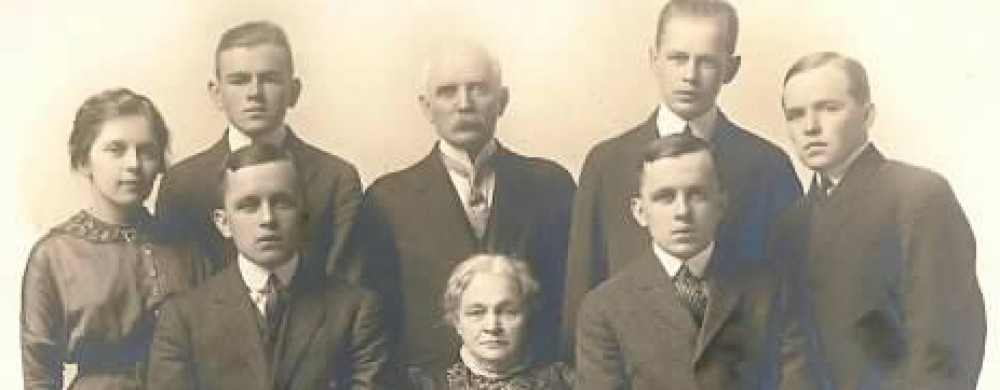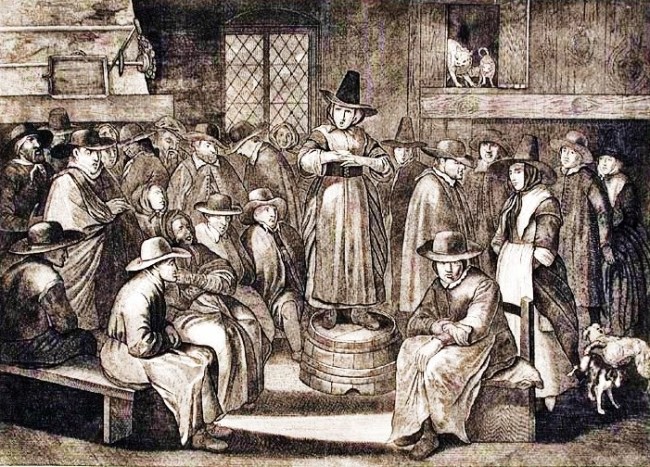The Brute and Bully At Home
George Barlow’s life before 1657 is a void. He brought to Sandwich, two sons, Moses and Aaron, but no wife. Some researchers conjecture the marriage and births took place in England, and that George may have had other children. Presumably, his first wife died and presumably, of natural causes, but this article is about George’s life with a new wife.
The year 1657 was a milestone for Jane Besse, too, albeit a sad one. Her husband Anthony, one of the town’s original founders, fell ill in February and died in May. In the 18 years before, Anthony and Jane had built a house in the Spring Hill section, improved land, acquired livestock and other necessities which sustained a family of five girls and two boys.
Anthony Besse had a will, a standard instrument to convey property to heirs, but details add color to the legalese. Anthony named Jane his executrix, proof that he trusted in her judgment and abilities (perhaps surprisingly, this action was not uncommon). My attention was drawn to the bequests:
“To Jane my wife, three Cowes… blacking Moose and Cherrey…
“To Dorcas my daughter two heifers… Nubbin and Spark and one more now
which we call young moose;
“To Ann my daughter one heifer which we call pretty
To Nehemiah my son one heifer formerly Disposed to him Called Coll:
“… unto my two sonnes…Nehemiah and David…two steers…Burnett & Raven;
“To my Daughter Mary one heifer wee call browne;
“To my Daughter Jane one heifer wee call Daysey.”
While most seventeenth century wills designate livestock like inanimate property (description – cows, steers, horses, etc. and a quantity), the Besse animals were unique individuals with names, – Nubbin, Spark, Pretty, Brownie, Daisy… suggesting the Besses were good-natured and caring folks. Anthony knew his children’s favorites and assigned parting gifts to make them happy. Yet, how hard it must have been for the Besses to be happy when this thoughtful and loving family man was gone from their lives!
Some months after burying Anthony, Jane gave birth to his last child. The widow had to cope with the needs of eight fatherless children, a house, farm, animals, – and grief, a burden daunting for the stoutest heart. We don’t know how long the Widow Besse was on her own, and typically, widows remarried. However, what moved Jane Besse to yoke herself to the cruel and tyrannical George Barlow – is beyond understanding.
The date of their marriage escaped record, but Plymouth County Court records document that it wasn’t going well. On March 4, 1661/62, Jane’s eldest daughters, Dorcas, Ann, and Mary Besse, went before the court for –
“crewell and unnatural practice toward their father-in-law George Barlow.”
Apparently, having failed to earn respect at home, George handled his stepdaughters the way he handled everyone who pissed him off, – he hauled them into court. To be fair, details of the case suggest the girls were not entirely blameless, and punishment was duly ordered.
At the same time, the court recognized the Barlow household was getting out of control. George and Jane –
“were both severely reproved for their most ungodly living in contention with the other, and admonished to live otherwise.”
Conflict was inevitable when George moved in with Jane, – into the house built by, and filled with memories of Anthony Besse. To make that situation work would have required a man of great sensitivity and delicacy, – not a man known from Cape Cod to Boston for his dickishness. George, the evil stepfather, appears in court again on June 3, 1662.
We learned above that Anthony Besse’s will gave his daughter Jane a heifer the little girl herself probably named Daysey (Daisy). Added on to Jane’s natural affection for Daisy, was the cow’s status as remembrance of her departed father. So George took it away. If he gave a reason for doing so, the court ruled it invalid:
“concerning a cow belonging to Jane, daughter of Anthony Bessey, of Sandwich, the Court have ordered G[e]orge Barlow, in whose hands the cow has been for some time, to return her to the overseers of the estate of the said Anthony Bessey, to be disposed of by them for the use and the good of the said Jane Bessey.”
In that same year (1662), two of the Besse girls he took to court, Ann and Mary, got married. This development would have significantly decreased domestic tension. Then in 1664, Nehemiah Besse, Jane’s eldest son, reached the age of majority and took over his father’s property. This prompted George and Jane to move some miles away from Spring Hill to Pocasset, (part of Bourne, Massachusetts today).
A change of scene can mean a fresh start in life, a chance to make things better, – but George got worse. On March 6, 1665/66, he was fined ten shillings for being drunk – a second time. Then in May 1665, he was accused of –
“attempting the chastity of Abigaill, the wife of Jonathan Pratt, by aluring words and actes of force.”
It seems surprising that after these public transgressions, Jane bore George two sons, John (about 1669) and Nathan (1670). Because she was also cited by the court for the couple’s scream fights, it’s doubtful she meekly forgave him. And, though it is awful to contemplate, the possibility that George also used “actes of force” on his wife is consistent with his character. In 1677 he was back in court for being “turbulent, and threatening to drive away the minister, Mr. Smith.” He returned in 1678 for being a “turbulent fellow” and was bound over for the next court session.
Fanatical, delusional, or just plain mean, George Barlow apparently believed he was right about everything. There’s no evidence he ever tried to reform his antisocial behavior, or regretted the terrible suffering he caused. He held grudges to the grave. In his will, to Aaron and Moses, sons of his first marriage, George gave only five shillings each, adding, “that is all I give them,” a verbal twist of the knife his sadistic nature couldn’t resist even as he prepared for death.
A widespread and popular story claims that George Barlow “ended his days alone and in want.” A version in Quaker tradition says he was reduced to begging for food and was fed by the very victims of his religious persecution. This would be poetic justice, karma, and just deserts for this horrendously horrible human being; if only it were true. For the Quakers especially, it’s morality tale stressing the virtue of forgiveness, even for enemies. In real life, the craven George Barlow got away clean.
As mentioned earlier, George had a will because he had an estate. While it may have amounted to less than his neighbors, – eight acres, a house, farm stock and equipment, and household furnishings, – it refutes the notion that George was destitute and starving on the streets of Sandwich.
He wasn’t alone at the end either. The sons he had with Jane, John and Nathan, managed to stay in his good graces; he named them co-executors. George left his house, land, livestock, and all remaining worldly goods to the boys and their mother. George made his will on August 4, 1684 and it was probated October 31, 1684, so he also had time to make spiritual reckoning and prepare any arguments he might need for a heavenly court.
Despite all that passed between them, there’s little doubt Jane Besse Barlow dutifully nursed her truculent husband to the end. The awful George Barlow most likely died in his own bed, surrounded by family on a lovely fall day. He would have imparted his final words (typically religious admonishments) and had a good death. So the tale of George Barlow illustrates that life is not fair!
Somehow, the Barlow progeny all appear to have been respected members of the community. The sweetest outcome is that some married into Quaker families. Barlow’s boys, John and Nathan, married and had seven sons between them, – but none of them carried the name George.
I imagine Jane was a happier widow this time around. I picture her pausing between chores to gaze toward the hearth for a moment. The aroma of a meat and vegetable stew emanates from an iron kettle and mingles with the scent of baking bread. Before the children and grandchildren tumble inside for the meal, Jane revels in the unaccustomed peace of her home, – and she whispers her heartfelt thanks to God.
SOURCES:
Plymouth Court Records. (Online database: AmericanAncestors.org, New England Historic Genealogical Society, 2010)
The Great Migration Begins: Immigrants to New England 1620-1633, Volumes I-III. (Online database: AmericanAncestors.org, New England Historic Genealogical Society, 2010)
Cape Cod, Its People and Their History, Henry C. Kittredge; 1930.
Sandwich Historical Society; http://sandwichhistory.org
The History of The Society of Friends on Cape Cod by James Warren Gould; http://www.capecodquakers.org/smm_history.html
George Barlow of Sandwich Massachusetts – From the research of Edson Barlow; Barlow Genealogy 1998-2004; http://www.barlowgenealogy.com/GeorgeofSandwich/georgemass.html


